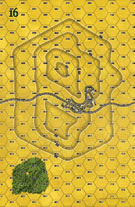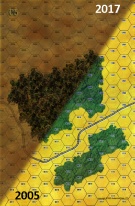|
A Strategic Hill Little Saturn #1 |
||
|---|---|---|
| (Defender) Italy | vs | Soviet Union (Attacker) |
| Formations Involved | ||
|---|---|---|
| Italy |  |
37º Reggimento Fanteria "Ravenna" |
| Italy |  |
3ª Divisone Fanteria "Ravenna" |
| Soviet Union |  |
58th Guards Rifle Division |

|
| Overall Rating, 7 votes |
|---|
|
3.57
|
| Scenario Rank: 370 of 958 |
| Parent Game | Little Saturn |
|---|---|
| Historicity | Historical |
| Date | 1942-08-20 |
| Start Time | 09:30 |
| Turn Count | 20 |
| Visibility | Day |
| Counters | 80 |
| Net Morale | 0 |
| Net Initiative | 1 |
| Maps | 4: 1, 15, 16, 6 |
| Layout Dimensions | 86 x 56 cm 34 x 22 in |
| Play Bounty | 167 |
| AAR Bounty | 154 |
| Total Plays | 6 |
| Total AARs | 3 |
| Battle Types |
|---|
| Hill Control |
| Conditions |
|---|
| Off-board Artillery |
| Randomly-drawn Aircraft |
| Reinforcements |
| Terrain Mods |
| Scenario Requirements & Playability | |
|---|---|
| Eastern Front | Maps + Counters |
| Fronte Russo | Counters |
| Little Saturn | Base Game |
| Road to Berlin | Maps |
| Introduction |
|---|
|
The German 294th Infantry Division had battled along the Don River for the Werch Mamon salient during the final part of July. This salient measured approximately ten kilometers deep and six wide. Although the Soviets had not been completely repulsed, the Wehrmacht still seized a strategic height (Hill 220) that dominated the whole area. From this position, the Germans possessed an unobstructed view over a great length of the Don River. But the Soviets could not be expected to give up so easily, and throughout this period continued launching attacks for control of the vital Don bridgeheads. The Italian Ravenna Division reached the front in early August and was soon handed the defense of the salient. On August 20th, after a few days of quiet, the Soviets proved they were still determined to gain a solid foothold on the south bank of the river. Despite being on site for a few days, the Italians had not yet consolidated their defensive positions. |
| Conclusion |
|---|
|
During the early hours of the day the Ravenna Division repulsed three consecutive attacks with minor losses thanks to accurate and timely artillery fire. A fourth attack at 0930 earned more success, and the Italians started to fall back. At that point the regimental reserve rallied the hard-pressed 2nd Battalion. Their wheeling maneuver threatened to surround the whole attacking force, convincing the Soviets to withdraw in disorder. Hill 220 was heavily attacked again the two following days. Although the Italian lines held, losses were mounting and there were no available reserves with the exception of two Blackshirt brigades attached at the corps level, whose use had to be authorized by the army command. Ravenna's staff eventually decided it was too costly to keep defending Hill 220, so the occupied zone in the salient was shrunk. This decision would have fatal consequences four months later as the Italians were no longer able to spot and keep under fire the Soviet forces in the bridgehead. The Red Army would launch its main strike from exactly this area during Operation Little Saturn. |

 LioF010
LioF010 
























